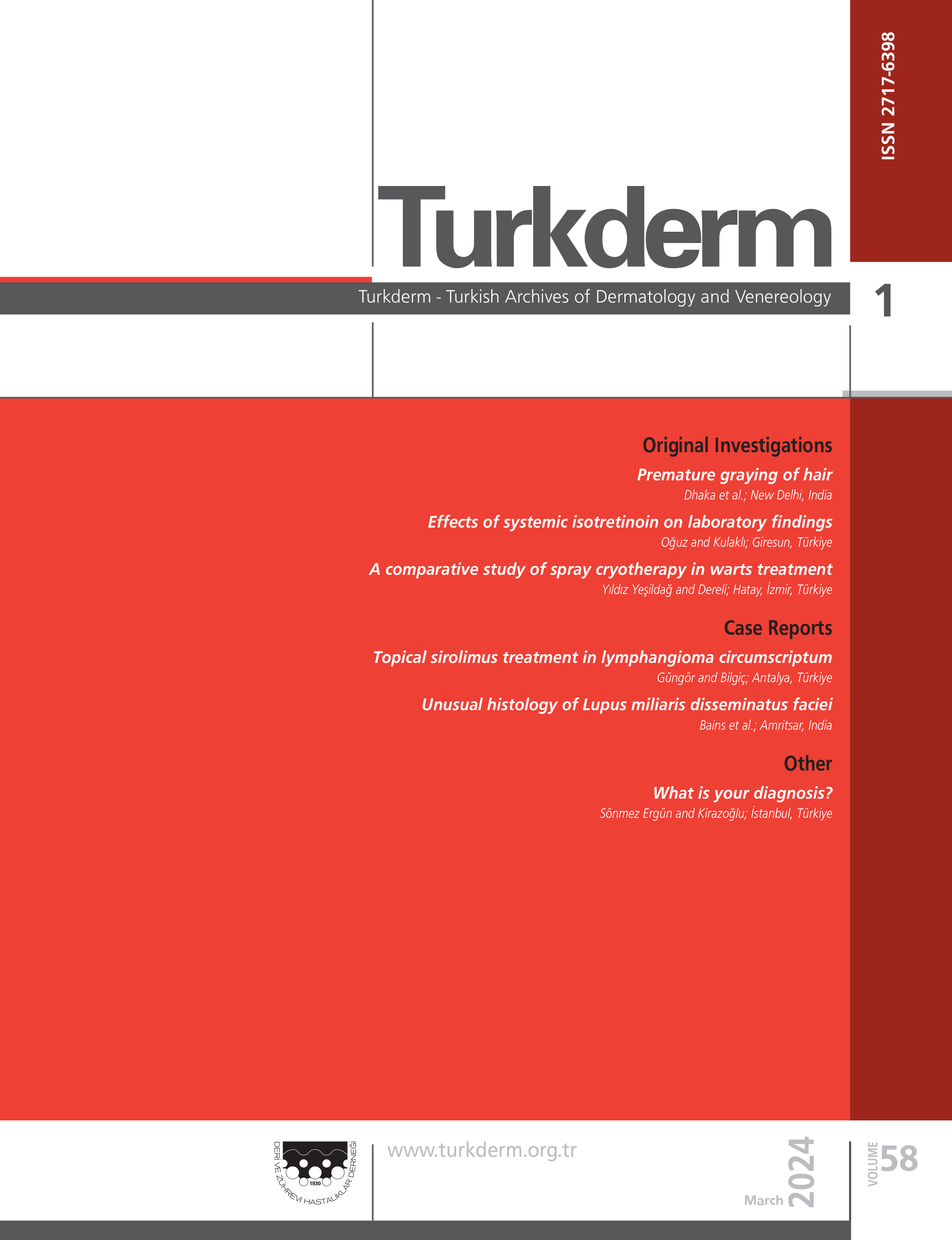Volume: 44 Issue: 4 - 2010
| EDITORIAL | |
| 1. | Updated Classification and Staging Cutaneous Lymphoma (2009) Nahide Onsun, Yeliz Erdemoğlu* doi: 10.4274/turkderm.44.178 Pages 178 - 179 Abstract | |
| REVIEW ARTICLE | |
| 2. | Steven-Johnson Syndrome (SJS) and Toxic Epidermal Necrolysis Erkan Alpsoy, Özlem Dicle, Ayşe Akman Karakaş doi: 10.4274/turkderm.44.180 Pages 180 - 186 Steven-Johnson sendromu (SJS) ve toksik epidermal nekroliz (TEN), nadir görülen, ancak yüksek ölüm hızına sahip, genellikle ilaçlara karşı gelişen ve yaygın epidermal nekrozla giden, birbiri ile yakın ilişkili bir grup hastalığı tanımlamak için kullanılır. Yaygın epidermis hasarının nedeni keratinositlerin apotozisidir. İlaçlar ya da metabolitlerinin hapten görevi görerek keratinositlerin yüzeyine bağlanmasının ve onları antijenik hale getirmesinin olayı başlattığı düşünülmektedir. İlaca özgül CD8(+) sitotoksik T hücrelerinin Fas/FasL ve perforin/granzim B yolağı ile keratinosit apotozisini tetikleyerek hastalığı başlattığı düşünülür. Çok sayıda ilaç etken olarak bildirilmişse de, en sık olarak sulfonamid grubu antibiyotikler, antikonvülzan ilaçlar, beta laktam grubu antibiyotikler, allopurinol, steroid olmayan antiinflamatuvar ilaçlar, nevirapin ve tiasetazon etken olarak saptanır. Erken tanı ve şüpheli ilaç ya da ilaçların hemen kesilmesi tedavinin en önemli basamaklarından birisidir. Ayırıcı tanıya giren diğer tabloların hızla dışlanması gerekir. Son yıllarda yerel ve sistemik tedavide kullanılan çok çeşitli seçeneklere rağmen ideal bir destekleyici bakım halen en önemli ve etkili tedavi yaklaşımıdır. TEN için geliştirilen bir ölçek olan SCORTEN hastalığın şiddetini ve buna bağlı olarak da ölüm hızını tahmin etmede yaygın olarak kullanılmaktadır. SCORTEN değeri 3 (ölüm hızı; %35,3) ve üzeri olan hastaların hızlı bir şekilde yanık ünitesi veya yoğun bakım ünitesine transfer edilmesi son derece önemlidir. Bu yazıda SJS-TEN yelpazesi güncel literatür bilgileri ışığında klinik özellikleri, etyopatogenez ve tedavisindeki gelişmelerle birlikte gözden geçirilmektedir. Stevens-Johnson syndrome (SJS) and toxic epidermal necrolysis (TEN) are rare, life-threatening conditions with a high mortality rate. SJS and TEN are used to denote a group of disorders closely related to each other, characterized by extensive epidermal necrolysis, and usually induced by drugs. Keratinocyte apoptosis is the main reason for widespread epidermal detachment. Drugs or their methobolites can act as a hapten after binding to the keratinocyte surface and initiate cytotoxic immunological attack. Drug- specific CD8+cytotoxic T cells mediate keratinocyte apoptosis by the Fas/FasL pathway and perforin/granzyme pathway. Although numerous drugs have been noted as responsible, sulfonamide class of antibiotics, anticonvulsants, beta-lactam antibiotics, allopurinol, nonsteroidal anti-inflammatory drugs, nevirapine and thiacetazone are the most frequently reported causative ones. Early diagnosis and withdrawal of suspected drug or drugs are one of the most important steps in the treatment. Other diseases resembling SJS/TEN should be excluded as soon as possible. Although various topical and systemic treatments have recently been used, ideal supportive care is still the most important and effective therapeutic approach. SCORTEN, a scoring system used to predict mortality in TEN, has been widely used in recent years. Transfer to a burn unit or intensive care unit is recommended for patients with a SCORTEN 3 (mortality rate; 35.3%) or over. In this paper, we aimed to review clinical findings, aetiopathogenesis and treatment of these syndromes in the light of current literature. |
| ORIGINAL INVESTIGATION | |
| 3. | Patch Test Results of 775 Patients with Allergic Contact Dermatitis Simin Ada, Ülkü Aşkın, Ayşe Tülin Güleç, Deniz Seçkin doi: 10.4274/turkderm.44.187 Pages 187 - 192 Amaç: Alerjik kontakt dermatitite yol açan alerjenler gerek ülkeler arasında, gerekse aynı ülkenin farklı coğrafik bölgelerinde ve zaman içerisinde değişkenlik göstermektedir. Deri yama testi sonuçlarının farklı merkezlerde belli aralıklarla tekrar değerlendirilerek karşılaştırılması önemlidir. Bu çalışmanın amacı, alerjik kontakt dermatit tanısı alan ve deri yama testi yapılan hastalarda sonuçların toplu olarak değerlendirilmesiydi. Gereç ve Yöntem: Bu çalışmada, polikliniğimizde Mayıs 1997 ile Mart 2009 tarihleri arasında alerjik kontakt dermatit tanısıyla deri yama testi yapılan 775 hastanın dosyaları retrospektif olarak incelendi. Hastaların yaş ve cinsiyet gibi demografik özellikleri ile kontakt dermatitin yerleşim yeri ve deri yama testi sonuçları kaydedildi. Bulgular: Deri yama testi yapılan 775 hastanın 581i (%75,2) kadın, 194ü (%25) erkekti. Hastaların 735inde Avrupa standart serisi, 318inde hem Avrupa standart serisi hem de kozmetik serisi, 40ında ise sadece kozmetik serisiyle deri yama testi yapıldı. Avrupa standart serisi ile yama testi yapılan 735 hastanın 255inde (%34,7) en az 1 pozitif reaksiyon saptandı. En sık reaksiyona yol açan 5 Avrupa standart serisi alerjeni sırasıyla; nikel sülfat (%17,3), kobalt klorid (%7,2), potasyum dikromat (%3), koku karışımı (%2,9) ve parafenilendiamin baz (%2,6) idi. Kozmetik serisi ile yama testi yapılan 358 hastanın 82sinde (%22,9) en az 1 pozitif reaksiyon saptandı. Kozmetik serisi alerjenleri arasında en sık pozitif reaksiyon saptanan 5 alerjen ise sırasıyla; octyl gallate (%3,9), thimerosal (%2,2), sorbitan sesquioleate (%2), Euxyl K 400 (%2) ve metildibromo glutarobromonitril (%1,4) idi. Sonuç: Çalışmamız, merkezimizin 12 yıllık süreçteki kontakt alerjen profilini göstermektedir. En sık saptanan alerjenler ve sıklık oranları, Türkiyenin çeşitli illerindeki merkezler arasında değişkenlik göstermektedir. Kontakt alerjen profilindeki bölgesel farklılıklar, aynı zaman diliminde yapılacak yeni çalışmalarla değerlendirilmelidir. Kozmetik alerjisi şüphesi olan hastalarda, kozmetik serisiyle yapılan deri yama testinde, özellikle octyl gallatea karşı izlenen alerjik reaksiyonların sıklığı dikkat çekmektedir. Background and Design: The allergens responsible for allergic contact dermatitis vary among countries and even between different geographical regions within the same country over time. It is of great importance to perform the patch test at certain intervals, to evaluate the results in different centers and to compare them afterwards. Our aim was to evaluate the patch test results in our patients with allergic contact dermatitis. Material and Method: The records of the patients with allergic contact dermatitis, who had been patch tested between May 1997 and March 2009, were analyzed retrospectively. The demographic features such as age and sex, localization of the contact dermatitis, and the patch test results were recorded. Results: Of the 775 patients, 581 (75.2%) were females and 194 (25%) males. Of all patients, 735 were patch tested with the European Standard Series, 318 - with both the European Standard Series and cosmetic series, and 40-with cosmetic series alone. Of the patients tested with the European Standard Series, 255 (34.7%) had at least one positive reaction. The most frequent allergen in the European Standard Series was nickel sulfate (17.3%), followed by cobalt chloride (7.2%), potassium dichromate (3%), fragrance mix (2.9%), and p-phenylenediamine base (2.6%). Of the 358 patients tested with cosmetic series, 82 (22.9%) had at least one positive reaction. The 5 most frequently observed cosmetic series allergens were octyl gallate (3.9%), thimerosal (2.2%), sorbitan sesquioleate (2%), Euxyl K 400 (2%) and methyldibromo glutaronitrile (1.4%). Conclusion: Our study shows the contact allergen profile of our center over 12 years. The most common allergens and their frequency differ between centers in various cities in Turkey. Those geographical differences should be re-evaluated by further studies performed in the certain time period. The high frequency of reactions to octyl gallate is an important finding in patients suspected of cosmetic allergy and who underwent patch testing with cosmetic series. |
| 4. | Patch Test Results with Standard and Cosmetic Series in Patients with Suspected Cosmetic-Induced Contact Dermatitis Şenay Hacıoğlu, Emel Bülbül Başkan, Şükran Tunalı, Hayriye Sarıcaoğlu doi: 10.4274/turkderm.44.193 Pages 193 - 199 Amaç: Bursa ve Güney Marmara Bölgesinde kozmetiklere bağlı kontakt dermatitten kuşkulanılan olgularda kozmetik kimyasallara karşı hassasiyeti Avrupa standart yama testi (ASYT) ve kozmetik seri yama testi (KSYT) sonuçları ile değerlendirmek. Gereç ve Yöntem: Kozmetik kullanımına bağlı kontakt dermatit şüphesi olan 73 hastaya ASYT ve KSYT yapıldı. Yama testi sonuçları yüzdelik olarak analiz edildi. Kozmetik ürünler ile kozmetik alerjenlerin ilişkisini göstermek için x2 testi kullanıldı. Bulgular: Çalışmaya alınan hastaların %90,4ü kadın, %9,6sı erkek; yaş ortalaması 37,5 (16-71) idi. Alerjik kontakt dermatitin (AKD) en sık yerleşim yerleri yüz (%49,3), el (%16,4), göz çevresi (%6,8), dudak (%6,8) ve boyun (%5,5) idi. Bu bölgelerde gelişen AKDlere en sık neden olan kozmetik ürünler ise sabunlar ve temizleyici tonikler (%32,8), nemlendiriciler (%21,9), makyaj malzemeleri (%15,0) ve saç boyaları (%9,6) idi. Hastaların %41,0inde standart veya kozmetik seriye ait en az bir kozmetik alerjen ile yama testi pozitifliği saptandı. ASYT serisinin kozmetiklerle ilişkili maddeleri ve bunlarla görülen pozitiflik oranları sırasıyla: fragrans miks (%6,8), lanolin (%5,5), fenilendiamin (%2,7), kolofoni (%1,4), paraben miks (%1,4), formaldehit (%1,4) ve metilkloroizotiazolinon (Kathon CG) (%1,4) idi. KSYT alerjenlerinden en sık pozitiflik saptanan alerjenler ise lanolin (%5,5), oktil gallat (%5,5), metildibromoglutaronitril/ pentoksietanol (%5,5), timerosal (%4,1), kokamidopropil betain (%4,1) ve tert-bütilhidrokinon (%4,1) idi. En sık yama testi pozitifliği saptanan kozmetik alerjen grupları koruyucular (%21,9), antioksidanlar (%8,2) ve kokular (%6,8) oldu. Sonuç: Yüz, boyun, göz kapakları, dudaklar, saçlı deri ve ellerde yerleşen egzema olgularında kozmetiklere bağlı alerjik veya iritan kontakt dermatitler düşünülmelidir. ASYTye ek olarak KSYT yapmak sorumlu alerjenlerin ortaya çıkarılmasında daha yararlı olabilir. Background and Design: Our aim was to evaluate the hypersensitivity to cosmetic chemicals in patients with clinically suspected cosmetic-induced contact dermatitis in Bursa and the South Marmara Region (Turkey) by patch testing with standard and cosmetic series. Material and Method: Seventy-three patients with clinically suspected contact dermatitis due to cosmetics were patch tested by the European standard series and cosmetic series. The patch test results were analyzed as percentages. x2 test was used to demonstrate the relationship between cosmetic products and cosmetic allergens. Results: 90.4% of patients in our study group were female and 9.6% were male; the median age was 37.5 (range 16-71) years. The most commonly involved parts of the body were the face (49.3%), hands (16.4%), periocular region (6.8%), lips (6.8%), and the neck (5.5%). The most common offending cosmetic products causing allergic contact dermatitis were soaps and cleansing lotions (32.8%), moisturizer creams (21.9%), make-up (15.0%), and hair dyes (9.6%). 41.0% of patients showed positive reaction to at least one cosmetic allergen included in either standard or cosmetic series. The cosmetic allergens in the standard series and the rates of positivity were as follows: fragrance mix (6.8%), lanolin alcohols (5.5%), paraphenylenedaimine (2.7%), colophony (1.4%), paraben mix (1.4%), formaldehyde (1.4%), and methylchloroisothiazolinone (Kathon CG) in descending order. The most common offending cosmetic allergen groups were preservatives (21.9%), antioxidants (8.2%) and fragrances (6.8%). Conclusion: Allergic or irritant contact dermatitis due to cosmetics should be considered in cases of eczema involving face, neck, eyelids, lips, scalp or hands. Patch testing with cosmetic series beside standard series would be more helpful in detecting the responsible allergen(s). |
| 5. | Investigation of Relationship Between Parvovirus B19 Infection and Psoriasis Mehmet Yıldırım, Ali Murat Ceyhan, Buket Cicioğlu Arıdoğan, İpek Gürses Koç, Selçuk Kaya doi: 10.4274/turkderm.44.200 Pages 200 - 203 Amaç: Psoriasis eritemli skuamlı papül ve plaklarla karakterize kronik tekrarlayıcı bir deri hastalığıdır. Hastalığın başlaması, yeni lezyon çıkışı veya alevlenmesini etkileyen üç önemli faktör mevcut olup bunlar stres, deri travması ve infeksiyondur. Psoriasisin ortaya çıkışı veya alevlenmesinde çeşitli mikroorganizmaların rolü olduğu bilinmektedir. Bu çalışmanın amacı, Parvovirus (PV) B19 ile psoriasis ve psoriasis alan şiddet indeksi (PASI) arasındaki ilişkiyi araştırmaktır. Gereç ve Yöntem: Çalışmaya 60 psoriasisli hasta (36 erkek, 24 kadın) ve 40 sağlıklı birey (22 erkek, 18 kadın) dahil edildi. Hasta ve kontrol grubunun PVB19 DNAsı real-time polimeraz zincir reaksiyonu ile ölçüldü. Bulgular: Hasta grubundaki 60 hastanın 27sinde (%45), kontrol grubundaki 40 bireyin 9unda (%22,5) PVB19 DNAsı tespit edildi (p<0,05). Ortalama viral yük hasta grubunda 9011768,5±6921223,3 kopya/ml, kontrol grubunda ise 106885,4±46828,1 kopya/ml olarak bulundu (p<0,05). Viral yük ile PASI arasında bir ilişki saptanmadı (p>0,05). Aynı zamanda viral yük ile psoriasis tipleri arasında da anlamlı bir ilişki yoktu (p>0,05). Sonuç: Elde edilen bulgular ile psoriasis ile PVB19 infeksiyonu arasında bir ilişki olabileceği sonucuna varıldı. Background and Design: Psoriasis is a common, chronic, relapsing skin disease, characterized by the formation of typical scaly papules or plaques. The three factors well-recognized as triggering the onset, causing new lesions or inducing a flare in the disease are: stress, skin injury and infection. Various microorganisms are associated with provocation and/or exacerbation of psoriasis. The aim of this study was to investigate the relationship between parvovirus B19 (PVB19) and psoriasis/psoriasis area severity index (PASI). Material and Method: Sixty patients with psoriasis (36 men, 24 women) and 40 healthy volunteers (22 men, 18 women) were included in our study. PVB19 DNA was quantified by real-time polymerase chain reaction. Results: PVB19 DNA was detected in 27 of 60 subjects in the patient group (45%) and in 9 of 40 controls (22.5%) (p<0.05). Viral load was quantitatively detected as mean 9011768.5±6921223.3 copies/ml in the patient group and 10688.4±46828.1 copies/ml in the control group (p<0.05). There was no correlation between viral load and PASI (p>0.05). The relationship between the viral load and the subtypes of psoriasis was not statistically significant (p>0.05). Conclusion: According to the results of this study, it was concluded that a relationship may be present between psoriasis and PVB 19 infection. |
| 6. | Coexistence of Metabolic Syndrome and Psoriasis Vulgaris Reyhan Çelik, Emine Derviş, Deniz Balaban, Günay Can doi: 10.4274/turkderm.44.204 Pages 204 - 208 Amaç: Psoriasis; romatoid artrit, sistemik lupus eritematozus, Crohn hastalığı gibi patogenezinde inflamasyonun rol oynadığı kronik inflamatuvar sistemik hastalıklar grubunda yer almaktadır. Son zamanlarda kronik inflamasyonun ateroskleroz patogenezinde önemine ve kronik inflamatuvar hastalıklar ile ateroskleroz-metabolik sendrom birlikteliğine değinen çalışmalar bulunmaktadır. Bu çalışmanın amacı değişik şiddetteki psoriasis vulgarisli hastalarda metabolik sendrom birlikteliğini araştırmaktı. Gereç ve Yöntem: Çalışmaya 100 psoriasis vulgarisli hasta, yaş ve cinsiyeti hasta grubuyla uyumlu 100 sağlıklı kontrol alındı. Psoriasisli hastalarda hastalığın şiddetinin değerlendirilmesinde PAŞİ kullanıldı. PAŞİ değeri 7nin altında olanlar hafif, 7-12 arası orta ve 12nin üzerinde olanlar şiddetli olarak kabul edildi. Hasta ve kontrol grubunda ATP III metabolik sendrom kriterleri kullanılarak metabolik sendrom araştırıldı. Verilerin değerlendirilmesinde SPSS for windows 10.0 istatistik paket programı kullanıldı. Karşılaştırmalarda students t, Mann Whitney U, ki-kare testleri kullanıldı. p<0,05 anlamlı kabul edildi. Bulgular: Psoriasisli hastalarda metabolik sendrom, hipertansiyon, açlık kan şekeri yüksekliği, trigliserid yüksekliği, bel çevresi artışı, HDL kolesterol düşüklüğü kontrol grubuna göre daha çok sayıda hastada görüldü; fakat iki grup arasında bu parametreler açısından istatistiksel olarak anlamlı bir fark yoktu (ki-kare testi) (p>0,05). Psoriasis grubunun ortalama trigliserid düzeyi kontrol grubuna göre istatistiksel olarak anlamlı derecede daha yüksek saptandı (p<0,05). HDL düzeylerinin ortalaması ise psoriasisli hastalarda kontrol grubuna göre istatistiksel olarak anlamlı derecede daha düşük bulundu (p<0,05). Hasta grubu hastalığın şiddeti açısından değerlendirildiğinde, bu parametrelerle birliktelik açısından istatistiksel olarak anlamlı bir farklılık bulunmadı (p>0,05). Sonuç: Hafif, orta ve şiddetli psoriasis hastaları ile kontroller arasında metabolik sendrom sıklığı açısından anlamlı farklılık gözlenmedi. Ancak psoriasisli hasta grubunun ortalama trigliserid düzeyi kontrol grubunun ortalama değerine göre daha yüksek ve HDL kolesterol düzey ortalaması daha düşüktü. Background and Design: Psoriasis is one of the chronic inflammatory systemic diseases, such as rheumatoid arthritis, systemic lupus erythematosus and Crohn's disease, in which the inflammation is responsible for the pathogenesis. Recently, some studies reported the importance of chronic inflammation in the pathogenesis of atherosclerosis and an association of chronic inflammatory systemic diseases with atherosclerosis and metabolic syndrome. The aim of this study is to determine coexistence of psoriasis vulgaris with various severity and metabolic syndrome. Material and Method: One hundred psoriasis vulgaris patients and one hundred sex- and age-matched healthy controls were included in this study. The Psoriasis Area and Severity Index (PASI) was used for evaluating the disease severity in psoriasis patients. A PASI score below 7 was accepted as mild, between 7-12 as moderate, and above 12 as severe. We evaluated metabolic syndrome in both patient and control groups by using the Adult Treatment Panel III (ATP III) metabolic syndrome criteria. SPSS 10.0 for Windows was used in analyzing data. For comparison, the students-t test, the Mann-Whitney U test and the chi-square test were used. A p-value less than 0.05 was considered statistically significant. Results: Metabolic syndrome, hypertension, elevated fasting plasma glucose and triglyceride levels, high waist circumference and lower high-density lipoprotein levels were more common in patients with psoriasis than in controls. However, there was no statistically significant difference in these parameters between these two groups (p>0.05). We found that the mean value of triglyceride levels was statistically higher in the psoriasis group (p<0.05), and the mean value of HDL cholesterol levels was statistically lower in psoriasis patients when compared with controls (p<0.05). There was no statistically significant difference in the association between these parameters and severity of psoriasis (p>0.05). Conclusion: No significant difference was observed between patients with mild, moderate, severe psoriasis and controls for the prevalence of metabolic syndrome. However, the mean value of triglyceride levels in psoriasis patients was higher and the mean value of HDL cholesterol levels was lower than those in the controls. |
| 7. | Leptin Levels in Patients with Behçet's Disease Işıl İnanır, Kamer Gündüz, Ece Onur, Timur Pırıldar, Ahmet Var, Nesrin Ölçer doi: 10.4274/turkderm.44.209 Pages 209 - 212 Amaç: Leptin aynı zamanda inflamatuvar süreçlerde de yeralan bir nöroendokrin hormondur. Behçet hastalığının patogenezinde önemli bir uyarıcı olan proinflamatuvar sitokinler leptin düzeylerini düzenlerler. Bu çalışmada, Behçet hastalarında leptin düzeylerinin kontrollerle karşılaştırılması ve hastalık aktivitesi ile korelasyonu amaçlanmıştır. Gereç ve Yöntem: Elli üç Behçet hastası (28 aktif ve 25 inaktif) ve 22 kontrol çalışma grubunu oluşturmuştur. Leptin tayinleri ticari kitler kullanılarak ELİSA yöntemi ile çalışılmıştır. Eritrosit sedimentasyon hızı ve C-reaktif protein de saptanmıştır. Bulgular: Leptin düzeyleri Behçetli hastalarda kontrollere kıyasla artmıştı, ancak hastalık aktivitesi ile korele değildi. Sonuç: Leptinin Behçet hastalığı patogenezinde bir rolü olabilir. Background and Design: Leptin is a hormone, which regulates neuroendocrine function and also is involved in inflammatory processes. Proinflammatorycytokines, important inducers in the pathogenesis of Behçets disease, up-regulate the leptin levels. In this study, we aimed to compare leptin levels in patients with Behcets disease to those in controls and to investigate the correlation between leptin levels and disease activity. Material and Method: Fifty-three patients with Behçets disease (28 active and 25 inactive) composed the study group and 22 subjects-the control group. Leptin analyses were done by ELISA method using commercial kits. Erythrocyte sedimentation rate and C-reactive protein levels were also measured. Results: Leptin levels were increased in patients with Behçets disease compared to controls. Leptin did not correlate with disease activity. Conclusion: Leptin might have a possible role in the pathogenesis of Behcets disease. |
| 8. | IL-2R, IL-6 and IL-8 Levels in Behçet's Disease Işıl İnanır, Ece Onur, Timur Pırıldar, Kamer Gündüz, Ahmet Var doi: 10.4274/turkderm.44.213 Pages 213 - 215 Amaç: İmmunolojik faktörler Behçet hastalığının multifaktöryel etyopatogenezinde önemli rol oynamaktadırlar. Özellikle Th1 hücreleri proinflamatuvar sitokinler ve nötrofil çekici kemokinler açığa çıkararak işlev görürler. Bu çalışmada Behçet hastalarında IL-2R, IL-6 ve IL-8 düzeyleri araştırılmıştır. Gereç ve Yöntem: Altmış-altı Behçetli hasta (36 inaktif ve 30 aktif) ve 22 sağlıklı kontrol çalışma grubunu oluşturmaktaydı. Sitokin analizleri ticari kitler kullanılarak ELISA yöntemi ile yapılmıştır. Ayrıca eritrosit sedimentasyon hızı (ESH) ve C-reaktif protein (CRP) çalışılmıştır. Bulgular: Tüm hastaların ve inaktif olanların IL-2R, IL-6 ve IL-8 düzeyleri kontrollerden farklı değildi. Hastalarda CRP ve ESR değerleri kontrollerden yüksekti. İnaktiflerle karşılaştırıldığında aktif hasta grubunda, IL-8 ve CRP düzeyleri artmıştı (p<0.05). Sonuç: Çalışmamız aktif Behçetli hastalarda mononükleer ve nötrofilleri çeken bir kemokin olan IL-8 düzeylerinin arttığını göstermiştir. IL-8 Behçet hastalığında bir aktivite belirteci olarak kullanılabilir. Background and Design: Immunological factors are considered to have an important role in the multifactorial ethiopathogenesis of Behçets disease (BD). Especially, Th1 cells function by expressing proinflammatory cytokines and neutrophil-attracting chemokines. Levels of IL-2R, IL-6 and IL-8 were evaluated in patients with BD in this study. Material and Method: Sixty-six patients with BD (36 with inactive and 30 with active) composed the study group and 22 subjects the control group. Cytokine analyses were done with ELISA method by using commercial kits. ESR and CRP levels were also measured. Results: IL-2R, IL-6 and IL-8 levels in all patients, including the inactive ones, were not different from those in controls. CRP and ESR levels in patients were higher than in controls. IL-8 and CRP levels were increased in patient with active BD (p<0.05) when compared to those with inactive BD. Conclusion: Our study demonstrated elevated levels of serum IL-8, a chemokine activating monunuclear cells and neutrophils, in patients with active BD. IL-8 may be considered as an activity marker for BD. |
| 9. | The Role of Matrix Metalloproteinase-2 in Vitiligo Treatment Heybet Özkaya Çelik, Demet Yılmazer, Damla Atacan, Fatma Eskioğlu, Murat Alper doi: 10.4274/turkderm.44.216 Pages 216 - 219 Amaç: Vitiligo deride fonksiyonel melanosit kaybı neticesinde görülen, iyi sınırlı depigmente maküllerle karakterize akkiz bir hipomelanotik bozukluktur. Dar bant ultraviyole B (dbUVB) vitiligo tedavisinde kullanılmaktadır. Tedavi sürecinde dbUVB'nin immün yanıtın düzenlenmesi, melanosit proliferasyonu ve migrasyonu gibi mekanizmalarla etkili olduğu düşünülmektedir. Melanosit migrasyonuna matriks metalloproteinaz-2 (MMP-2) aktivasyonunu artırarak katkı sağladığı yönünde yayınlar mevcuttur. Biz çalışmamızda dbUVB tedavisi ile repigmentasyon sağladığımız vitiligo plaklarında tedavi öncesine göre MMP-2 seviyesinin artıp artmadığını, dolayısıyla vitiligo tedavisinde rolü olup olmadığını immünohistokimyasal olarak test etmek istedik. Gereç ve Yöntem: Çalışmamıza vitiligo tanısı alan, öncesinde tedavi almamış, herhangi bir sistemik hastalığı bulunmayan 23 erişkin hasta dahil edildi. Hastalara dbUVB tedavisi uygulandı. Tedavi öncesi vitiligo plağından alınan biyopsi materyali ile, aynı vitiligo plağının dbUVB tedavisi sonrası pigmente olan bölgesinden alınan biyopsi materyali MMP-2 tutulum şiddeti açısından immünohistokimyasal olarak incelendi. Bulgular: Tedavi öncesi ve sonrasındaki MMP-2 antikor boyanma şiddetleri değerlendirildi ve aradaki fark istatistiksel olarak anlamlı bulundu. Sonuç: Çalışma sonuçlarımız, MMP-2nin dbUVB tedavisi ile artabildiği ve vitiligo repigmentasyon sürecinde etkin bir role sahip olabileceği yönündedir. Background and Design: Vitiligo is an acquired hypomelanotic disorder characterized by circumscribed depigmented macules in the skin resulting from the loss of functional melanocytes. Narrowband-ultraviolet B (NB-UVB)has been used in vitiligo treatment. Possible mechanisms by which NB-UVB induces repigmentation in vitiligo are: regulation of the immune response, melanocyte proliferation and melanocyte migration. In melanocyte migration, the efficacy of NB-UVB might derive from induction of metalloproteinase-2 (MMP-2). In our study, we aimed to test whether there would be an increase in MMP-2 levels by NB-UVB treatment. Material and Method: Twenty-three adult vitiligo patients without any systemic disease and who have not received treatment previously were included in this study. The patients were treated with NB-UVB irradiation. Biopsy specimens taken from all patients before and after the treatment were compared in terms of MMP-2 immunoreactivity. Results: There were statistically significant differences in MMP-2 immunostaining between the tissue specimens taken before and after the treatment. Conclusion: Our study results suggest that the NB-UVB therapy can increase the MMP-2 activity, and MMP-2 may have an important role in vitiligo repigmentation process. |
| CASE REPORT | |
| 10. | Unilateral Nevoid Telangiectasis: Report of Five Cases Zehra Aşiran Serdar, Şirin Yaşar, Canan Aslan, Pembegül Güneş, Cuyan Demirkesen doi: 10.4274/turkderm.44.220 Pages 220 - 223 Unilateral nevoid telenjiektazi (UNT), unilateral dağılım gösteren, yüzeyel telenjiektazik yamalarla karakterize, nadir görülen bir hastalıktır. Konjenital ve akiz olmak üzere iki tipi tanımlanmıştır. Akiz form gebelik, puberte, siroz, hepatit C ile birlikte görülebilir. Ayrıca sağlıklı olgularda bildirilmiştir. Etyolojisinde kanda östrojen seviyelerinin yüksekliği ve/veya tutulan deride östrojen ve progesteron reseptörlerinin artışının bu tabloya neden olduğu ileri sürülmektedir. Burada altta yatan bir hastalık tespit edilemeyen, 26-33 yaşları arasında dört erkek olgu ile hepatit B taşıyıcılığı saptanan 18 yaşında akkiz UNT tanısı konan bir bayan olgu sunulmaktadır. Unilateral nevoid telenjiektazi nadir görülmesi nedeniyle literatür bilgileri ile birlikte tartışılmıştır. Unilateral nevoid telangiectasia (UNT) is a rare cutaneous disorder characterized by superficial telangiectasias distributed unilaterally. UNT can be congenital or acquired. Acquired UNT may be seen during pregnancy, puberty, and in association with cirrhosis and hepatitis C. Besides, the disease has been reported in healthy individuals. In the etiology, elevated blood estrogen levels and/or increased estrogen and progesterone receptors in the involved skin are suggested to cause this disorder. Here, we present four male patients aged 26-33 years, without an identified underlying disease and an 18-year-old female hepatitis B carrier with diagnosis of acquired UNT. Since UNT is seen rarely, it is discussed in the light of the literature data. |
| 11. | Idiopathic Acquired Aquagenic Keratoderma Localized to Dorsum of the Hands Berna Aksoy, Aslı Altaykan Hapa doi: 10.4274/turkderm.44.224 Pages 224 - 228 Edinsel akuajenik keratoderma kısa süreli su teması sonrası oluşan, sıklıkla simetrik ve palmar bölgelere yerleşen, ender bir edinsel palmoplantar keratoderma türüdür. Kırk iki yaşında erkek olgu 3 yıldır ellerde su teması ve terleme ile ortaya çıkan kabarıklıklar ve çukurlar şikayetiyle polikliniğimize başvurdu. Dermatolojik muayenede hastanın ellerinin kısa süreli su ile teması sonrasında el dorsal yüzlerde beyazımsı keratodermik masere plaklar ve bu plaklar içinde dilate punktalar gözlendi. Ellerin kuruması sonrası bu belirtilerin gerilediği saptandı. Hastaya klinik olarak edinsel akuajenik keratoderma tanısı konuldu. Bu olgu literatürde saptanabilen el dorsumuna lokalize edinsel akuajenik keratoderma olgularına eklenen üçüncü olgu olması nedeniyle ilginçtir. Bu makalede olgumuz vesilesiyle nadir görülen edinsel akuajenik keratoderma literatür özeti eşliğinde gözden geçirilmiştir. Acquired aquagenic keratoderma is a rare type of acquired palmoplantar keratoderma localized frequently and symmetrically to palms and occurs following short period of water exposure. A 42-year-old male patient applied to the outpatient clinic with complaints of elevated lesions and pores located on the hands and precipitated by water exposure and perspiration. On dermatological examination, whitish keratodermic macerated plaques and dilated punctae were observed over the dorsum of the hands following exposure of patients hands to water for a short period of time. These findings regressed gradually after drying the hands. The patient was clinically diagnosed to have acquired aquagenic keratoderma. This case turned out to be interesting as it is the third case of acquired aquagenic keratoderma with localization on the dorsum of the hands, and it has been added to the ones already present in the literature. Here, we have reviewed the literature about acquired aquagenic keratoderma and reported our case. |
| 12. | Acrokeratoelastoidosis: A Case Report Jale Yüksek, Engin Sezer, Doğan Köseoğlu, Fatma Markoç doi: 10.4274/turkderm.44.229 Pages 229 - 231 Akrokeratoelastoidozis (AKE) el ve ayakların kenarlarında küçük, sert, sarı papüllerle karakterize nadir görülen bir papuler palmoplantar keratozdur. Hastalığın hem otozomal dominant hem de sporadik formları bildirilmiştir. Histolojik bulguları arasında hiperkeratoz, akantoz ve dermiste elastik liflerde belirgin azalma yer alır. Günümüze kadar AKEin küratif tedavisi bildirilmemiştir. Bu makalede AKE tanısı alan 15 yaşında sporadik bir kız olgu sunulmakta ve ayırıcı tanı gözden geçirilmektedir. Acrokeratoelastoidosis (AKE) is a rare papular palmoplantar keratosis characterized by small, firm, yellow papules distributed on the margins of the hands and feet. Both autosomal dominant and sporadic forms of the disease have been reported. Histologic findings consist of hyperkeratosis, acanthosis and marked decrease in dermal elastic fibers. No curative treatment of AKE has been reported to date. In this article, we present a sporadic case of a 15-year-old female patient diagnosed with AKE and discuss the differential diagnosis. |
| 13. | Giant Cornu Cutaneum Yavuz Yeşilova, Sinan Soylu, Şule Bakır, Cahit Yavuz doi: 10.4274/turkderm.44.232 Pages 232 - 234 Korn kutaneum birkaç milimetre ile santimetre arasında değişebilen, boynuzumsu görünümde hiperkeratozik lezyonlardır. Korn kutaneum sıklıkla yüz, kulaklar ve güneş gören diğer alanlarda görülür. Korn kutaneum, benin, premalin ve malin lezyonlarla ilişkili olabilir. Bu yazıda sağ yanakta 5 yıldır biri dev olmak üzere 2 adet korn kutaneum lezyonu bulunan 71 yaşındaki bayan hasta sunulmaktadır. Cornu cutaneum is a lesion with hyperkeratoses resembling that of an animal horn and its length varies from a few millimeters to centimeters. Cornu cutaneum is most commonly located in face, ears and other exposed areas. Cornu cutaneum may be associated with benign, pre-malignant and malignant lesions. In this case report we present a 71 years old woman suffering from two cornu cutaneum of which one is called giant cornu cutaneum located in the right cheek for 5 years. |
| WHAT IS YOUR DIAGNOSIS? | |
| 14. | Tanınız Nedir? Jale YüksekPages 235 - 236 Abstract | |
| NEWS | |
| 15. | Haberler Page 237 Abstract | |
| NEW PUBLICATIONS | |
| 16. | Aesthetic Applications of Intense Pulsed Light Page 238 Abstract | |
| 17. | 2010 Refree Index Page 239 Abstract | |
| 18. | 2010 Author Index Pages 240 - 241 Abstract | |
| 19. | 2010 Subject Index Pages 242 - 243 Abstract | |






















